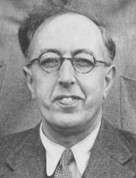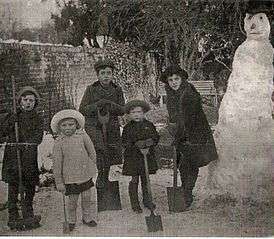Max Barrett
| Arthur Max Barrett | |
|---|---|
 | |
| Born |
28 July 1909 Thaxted, Essex, England |
| Died |
11 December 1961 (aged 52) Cambridge, England |
| Nationality | United Kingdom |
| Fields | Medicine (Pathology) |
| Institutions | University of Cambridge |
| Alma mater | Pembroke College, Cambridge |
| Known for |
|
| Influences | Henry Roy Dean |
| Notable awards | Raymond Horton-Smith Prize (1960) |
Arthur Max Barrett, MD (28 July 1909 – 11 December 1961), also known as Dr. A. M. Barrett, was a university morbid anatomist and histologist at the University of Cambridge, and an honorary consulting pathologist to the United Cambridge Hospitals and to the East Anglian Regional Hospital Board. He wrote numerous works, often cited in medical literature.[1][2] The Barrett Room at Addenbrooke's Hospital is named in his honour. He was the father of Syd Barrett, a founder member of the band Pink Floyd.[3]
Biography
Early life

Arthur Max Barrett was born in 1909 in the English town of Thaxted, in Essex, where he spent his boyhood. His father Arthur Samuel Barrett was a retail businessman (who employed three men at Thaxted as Grocer, Draper & Farmer Of 36 Acres).[4][5] His mother Alice Mary (née Ashford) was daughter of Rev. Charles Ashford, who was Congregational Minister at Thaxted for 19 years, and Ellen, née Garrett, who was known as a cousin of Elizabeth Garrett Anderson, although research on Syd Barrett's genealogy has not found any relation.[2][4]
Max Barrett had a religious family background and was educated first at the grammar school of Newport, Essex (now Newport Free Grammar School). When the family had moved to Cambridge he attended the Cambridge and County High School (now Cambridgeshire High School for Boys). Early he was interested in scouting (with the Cambridge County School Troop he became troop leader and gained a King's Scout Badge) as well as in music, aural birding and botany, which improved the expeditions with his sister Doreen for birds and flowers, and inspired his later interests in music and science.[1][2]
Later years
Deciding on a career in medicine, in 1927 he won a State Scholarship to Cambridge University, coming up to Pembroke College in 1928. There he obtained a considerable number of awards and honours: a Major Scholarship in 1928; a Shoolbred Scholarship in 1930; a First Class place in the Natural Science Tripos Part I in 1930 and in Part II in 1931 (Part II course in Pathology was introduced in 1925 by Prof. Henry Roy Dean, with whom he first came under influence);[1][2] a Foundress Scholarship in 1931; five prizes during his clinical training in the London Hospital Medical College (where he went as an entrance scholar in Pathology); a Raymond Horton-Smith Prize for his MD degree thesis (submitted in 1960). He graduated MB BCh in 1934.
He worked in the wards and laboratories of the London Hospital from 1934 to 1938 and was University Demonstrator in Cambridge from 1938 to 1946, the only one in the Department of Pathology during the war years, having a large part of the teaching responsibility. He was also an examiner for the Institute of Medical and Laboratory Technology, London.
When he returned in Cambridge in 1938 other than teaching he was in the same time actively interested both in the routine pathology services of Addenbrooke's Hospital, and as member of the Cambridge Philharmonic Society as well, where he was Honorary Secretary for more than 20 years, and where "an enviably deep bass" was remembered among his musical abilities. In 1946, when that services were saddled to the university, he became consultant for the hospital as University Morbid Anatomist and Histologist.[1]
Being a keen botanist, he was provided with his own set of keys to the Cambridge University Botanic Garden.[6] He often made histological examinations of the field fungi he carefully preserved and recorded for his collection, and gave some valued opinions on rare fungi during Autumn field meetings of the British Mycological Society.[1][2]
Death and legacy
A week before his death at 52 his pathological work continued.[2] Inoperable cancer was diagnosed and Max Barrett died suddenly on 11 December 1961.[3] In his 1961 obituary it was said about him:
He believed in the precise use of language […]. His advice was constantly sought by pathologists in East Anglia and elsewhere, never without profit.[…] When he spoke at the Faculty Board of Medicine or as secretary of the Degree Committee everyone recognized it as a carefully balanced statement worthy of consideration. […] His family life was a happy one: tea with the Barretts was fun, for he had imparted to his family his unbounded curiosity, which was, in the view of many friends, his most endearing characteristic.[1]
The youngest of his five children, Roger, later known as Syd, and Rosemary, were 15 and 14 years old respectively.[7] Later a venue in a private ward at the Addenbrooke's Hospital in Cambridge, used for seminars, training, meeting, consulting and conferences, was named Barrett Room in his honour.[3]
Works
The following list of A. M. Barrett's works is taken from his obituary on the official journal of the Pathological Society of Great Britain and Ireland (now The Journal of Pathology) published in January 1964. Here the list is in MLA format. Some supposed minor works like the ones on mycology (study of the fungi) were missing there.[8]
- Barrett, A. M.; Stewart, Halley (1938). "A special form of erythrocyte possessing increased resistance to hypotonic saline". The Journal of Pathology and Bacteriology. 46 (3): 603–618. doi:10.1002/path.1700460319.
- Barrett, A. M. (2009). "The serological diagnosis of glandular fever (infectious mononucleosis): A new technique". Journal of Hygiene. 41 (3): 330–43. doi:10.1017/S0022172400012535. PMC 2199768
 . PMID 20475599.
. PMID 20475599. - Barrett, A. M.; Cole, L. (1944). "A Case of Tuberculous Pericarditis". Heart. 6 (4): 185–90. doi:10.1136/hrt.6.4.185. PMC 503542
 . PMID 18609977.
. PMID 18609977. - Barrett, A. M. (1944). "A method for staining sections of bone marrow". The Journal of Pathology and Bacteriology. 56: 133–5. doi:10.1002/path.1700560116.
- Barrett, A. M. (1944). "On the removal of formaldehyde-produced precipitate from sections". The Journal of Pathology and Bacteriology. 56: 135–6. doi:10.1002/path.1700560117.
- Bowen, WH; Barrett, AM (1946). "A case of anuria". The Clinical journal. 75: 52–5. PMID 21019000.
- Barrett, AM; Cole, L (1946). "Pulmonary Vascular Sclerosis with Right Ventricular Failure". British heart journal. 8 (2): 76–82. doi:10.1136/hrt.8.2.76. PMC 480996
 . PMID 18610031.
. PMID 18610031. - Needham, DM; Cohen, JA; Barrett, AM (1947). "The mechanism of damage to the bone marrow in systemic poisoning with mustard gas". The Biochemical Journal. 41 (4): 631–9. doi:10.1042/bj0410631. PMC 1258550
 . PMID 16748227.
. PMID 16748227. - McCance, RA; Barrett, AM (1951). "Studies of undernutrition, Wuppertal 1946-9. III. The effect of undernutrition on the skin". Special report series. 275: 83–96. PMID 14866590.
- McCance, RA; Dean, RF; Barrett, AM (1951). "Studies of undernutrition, Wuppertal 1946-9. VI. Enlargement of the parotid glands". Special report series. 275: 135–9. PMID 14866593.
- Barrett, AM; Gairdner, D; McFarlan, AM (1952). "An outbreak of encephalitis, possibly due to poliomyelitis virus". British Medical Journal. 1 (4772): 1317–22. doi:10.1136/bmj.1.4772.1317. PMC 2023751
 . PMID 14935244.
. PMID 14935244. - Barrett, A.M. (1954). Gairdner, D., ed. "Sudden death in infancy". Recent advances in pediatrics. London: 301–20.
- Barrett, AM; Fairweather, DV; McCance, RA; Morrison, AB (1956). "Genetic, clinical, biochemical, and pathological features of hypophosphatasia; based on the study of a family". The Quarterly journal of medicine. 25 (100): 523–37. PMID 13379604.
- McCance, RA; Butler, RW; Barrett, AM (1958). "Unexplained destruction of the shaft of the femur in a child". The Journal of bone and joint surgery. British volume. 40–B (3): 487–93. PMID 13575462.
- Barrett, A.M.; Gresham, G.A. (1958). "Acute Streptococcal Myositis". The Lancet. 271 (7016): 347–351. doi:10.1016/S0140-6736(58)90971-1.
- Coombs, R.R.A; McLaughlan, P (1982). "The Enigma of Cot Death: Is the Modified-Anaphylaxis Hypothesis an Explanation for Some Cases?". The Lancet. 319 (8286): 1388–1389. doi:10.1016/S0140-6736(82)92503-X.
- Parish, W.E.; Barrett, A.M.; Coombs, R.R.A.; Gunther, Mavis; Camps, Francise (1960). "Hypersensitivity to Milk and Sudden Death in Infancy". The Lancet. 276 (7160): 1106–10. doi:10.1016/S0140-6736(60)92187-5. PMID 13732812.
- Fairbank, T. J.; Barrett, A. M. (1961). "Vastus intermedius contracture in early childhood: Case report in identical twins". The Journal of bone and joint surgery. British volume. 43–B (2): 326–34.
- Barrett, A. M. (1963). "Arterial measurements in the interpretation of cardiomegaly at necropsy: Cardiac hypertrophy and myocardial infarction". The Journal of Pathology and Bacteriology. 86: 9–20. doi:10.1002/path.1700860103. PMID 13969522.
References
- 1 2 3 4 5 6 "Obituary: A. M. Barrett, M.D.". British Medical Journal. 2 (5269): 1788–9. 1961. doi:10.1136/bmj.2.5269.1788-a. PMC 1970890
 .
. - 1 2 3 4 5 6 Dixon, Kendal C.; Herbertson, B. M. (1964). "Arthur Max Barrett. 28 July 1909—11 December 1961". The Journal of Pathology and Bacteriology. 87: 191–6. doi:10.1002/path.1700870128. PMID 14106346.
- 1 2 3 Jones, Cliff (September 1996). "Wish You Were Here". Mojo. London: Emap. Retrieved 29 March 2014.
- 1 2 "All results for Arthur Max Barrett". Ancestry.com. Retrieved 11 February 2012.
- ↑ Munro, Bruce. "Thaxted at War". Thaxted. BBC. Retrieved 19 July 2005.
- ↑ "Seeing Pink - a Floyd gazetteer of Cambridge". Cambridge News. Retrieved 20 February 2009.
- ↑ Palacios, Julian (2010). Syd Barrett and Pink Floyd: Dark Globe. London: Plexus. p. 15. ISBN 9780859654319.
- ↑ Watkinson, Mike; Anderson, Pete (1991). Crazy Diamond: Syd Barrett and the Dawn of Pink Floyd (2006 ed.). London: Omnibus Press. p. 13. ISBN 9780857121226.
